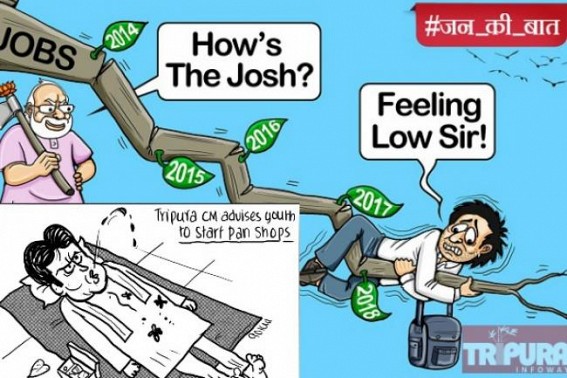TIWN Jan 25, 2020

AGARTALA, Jan 25 (TIWN): Like 23rd January, BJP is all set to teach nationalism to the people in Tripura when the party itself is duped in corruption, pre-poll fraud political ways of the party in the name of 50000 Govt jobs, house to house jobs etc. Tripura was promised to give 50000 Govt jobs in first 1-year if wins the election, but BJP Govt fails to fulfil it even 2%. Across India the situation is same. At least two in every five young Indians are not part of the workforce or have no link with education or any form of training, a UN report has said, putting the country behind Pakistan, Bangladesh, Afghanistan and Sri Lanka on these parameters.The World Economic Situation and Prospects 2020 report, released here on Friday, said over 40 per cent of Indians aged between 20 and 34 were Not in Education, Employment or Training (NEET) for the period between 2010 and 2018.
On the other side, Tripura tops in unemployment rates among all Indian states. CMIE’s monthly data has topped Tripura in unemployment rate once again with 28.6%.
After Tripura, it is Haryana which is the second topper in unemployment rate with 27.6% unemployment rate. The rate has increased 20% in last 21 months.Nationally unemployment rate is 7.7% which is also very high CMIE, or Centre for Monitoring Indian Economy, is a leading business information company. It was established in 1976, primarily as an independent think tank.
The corresponding youth NEET rate — which represents young people outside employment, education or training — was one-third for other South Asian countries like Afghanistan, Bangladesh, Pakistan and Sri Lanka.
Nagesh Kumar, head, UN Economic and Social Commission for Asia and the Pacific, said India needed to focus more on education to make the most of its demographic dividend.
“India is a youthful country. There cannot be a better investment than education,” Kumar told reporters.
Professor Ravi Srivastava, a labour economist, said the NEET category would include those engaged in domestic work and even homemakers.
Srivastava said: “Among those who are outside the labour force, a major population is engaged in domestic duties. The rate of participation in the workforce is high among women in Bangladesh compared with India. Besides, the unemployment rate in India has increased to a very high level because of a lack of job creation. That is why the NEET is high in India.”
He said the Periodic Labour Force Survey released by the Centre had found the unemployment rate in India was 6.1 per cent in 2017-18, the highest since 1972-73. While the unemployment rate has increased in India, the world average has declined.
The UN report said the world unemployment rate had fallen to slightly under 5 per cent, about the same level as before the global financial crisis of 2008.
“The decline in global unemployment over the past year is mainly the result of further job gains in major developed economies. In the United States, unemployment fell in 2019 to a 50-year low of 3.6 per cent. Unemployment in Japan stands at 2.2 per cent, its lowest in 27 years,” it said.
The report said that equal access to education would encourage a more level playing field in terms of access to quality jobs and wages.
“The social returns from an educated workforce are substantial and generally include increased productivity and civic engagement and a reduction in crime. This may be supported by upgrading school infrastructure, targeting resources to disadvantaged students and schools, providing early childhood education, and establishing teacher training programmes.”
According to the report, income inequalities increased in India, Bangladesh and Sri Lanka between the early 1990s and the early 2010s, with the top 10 per cent of earners in India receiving 54.2 per cent of the total national income.
The report said girls were substantially less likely than boys to complete their secondary or higher education, and that half the number of girls in South Asia were married off before they turned 18, limiting their prospects for meaningful participation in the labour market.
The report was mainly about GDP projections. Nagesh Kumar said India would grow at a rate of 5.8 to 5.9 per cent in 2020-21.
- Lok Sabha Poll : Two Polling Personnel suspended ; 2 miscreants were arrested in Agartala
- ‘Oppositions’ allegation about Poll Rigging is Fake’ : BJP State President
- CM casts Vote, appeals to all Voters to cast their Votes
- Miscreants set fire to a scooty in Bankumari
- Three shops were affected in a massive fire in Khowai



